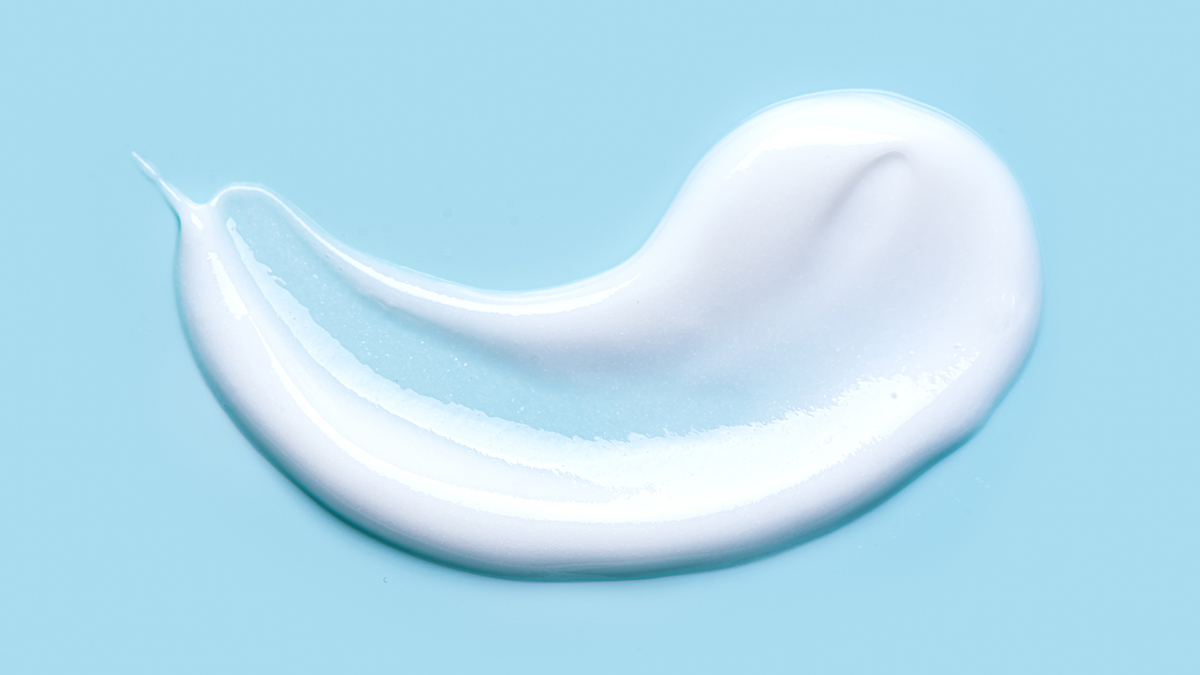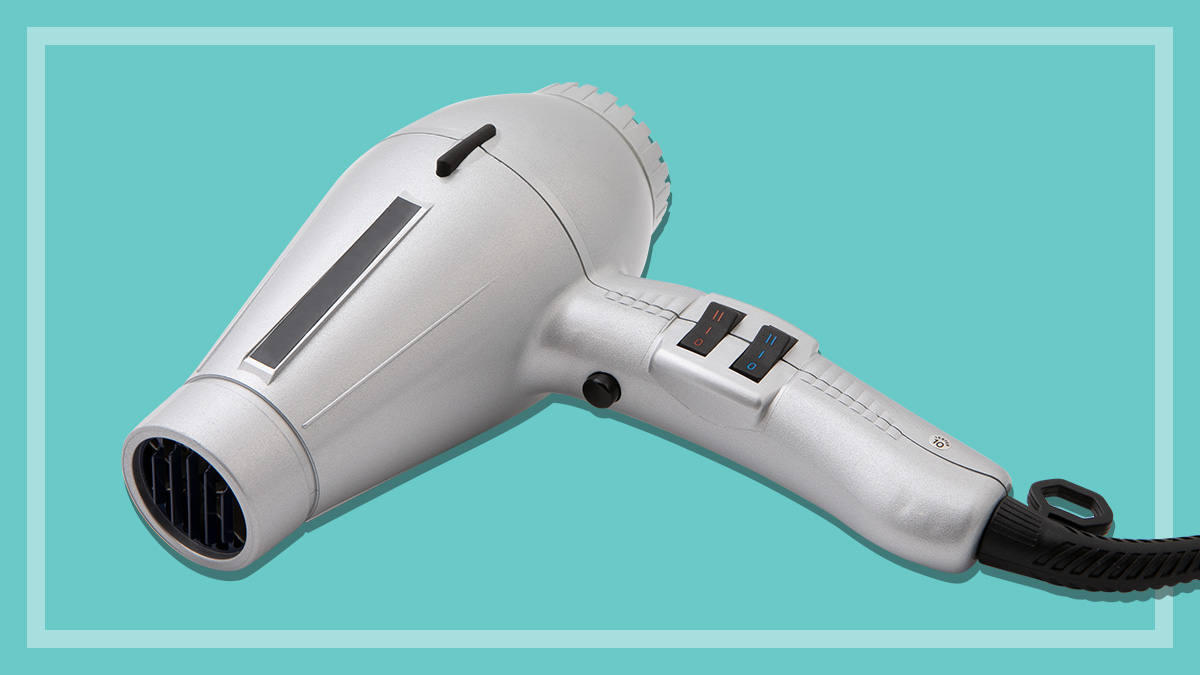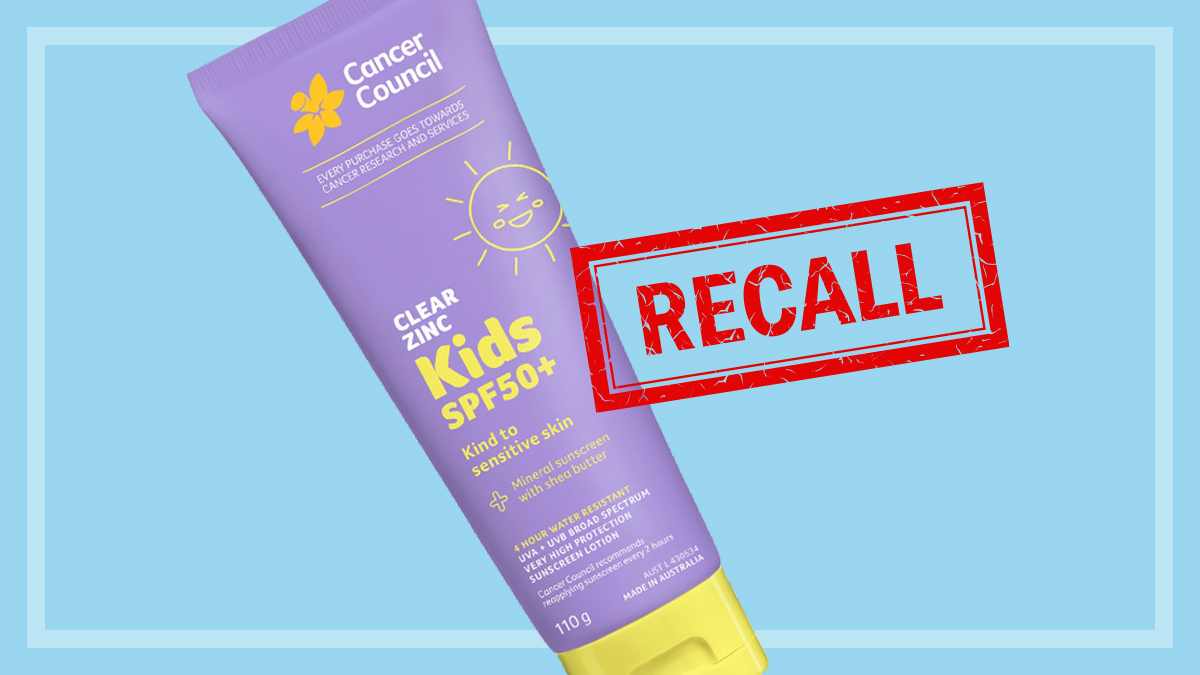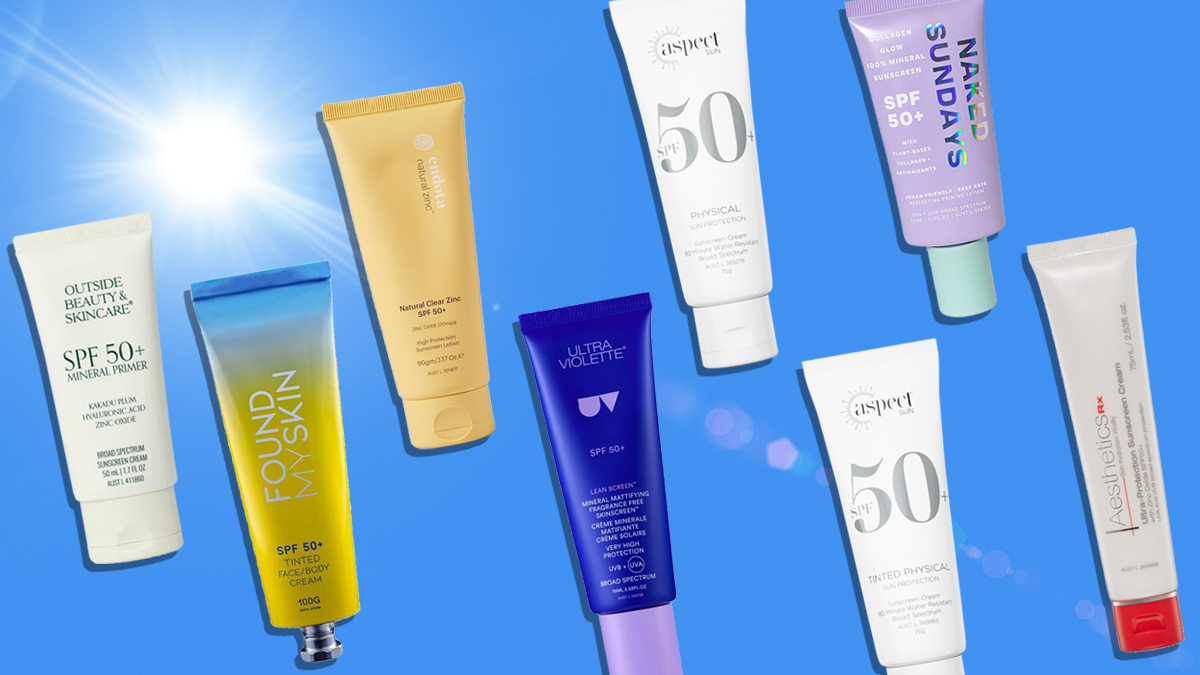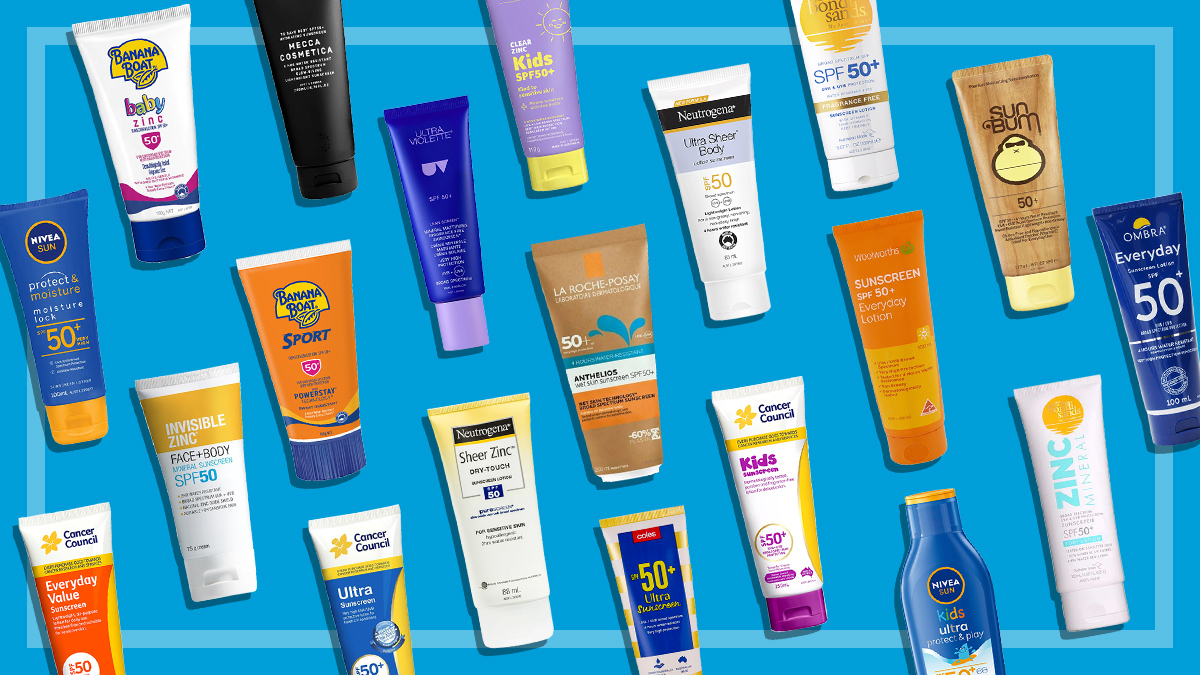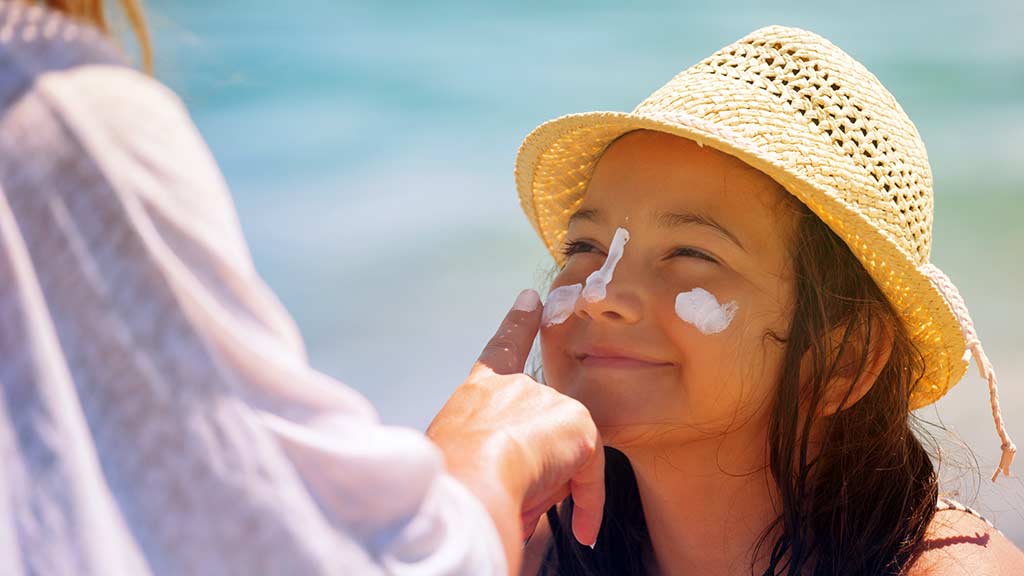Get our independent lab tests, expert reviews and honest advice.
How to buy and use sunscreen
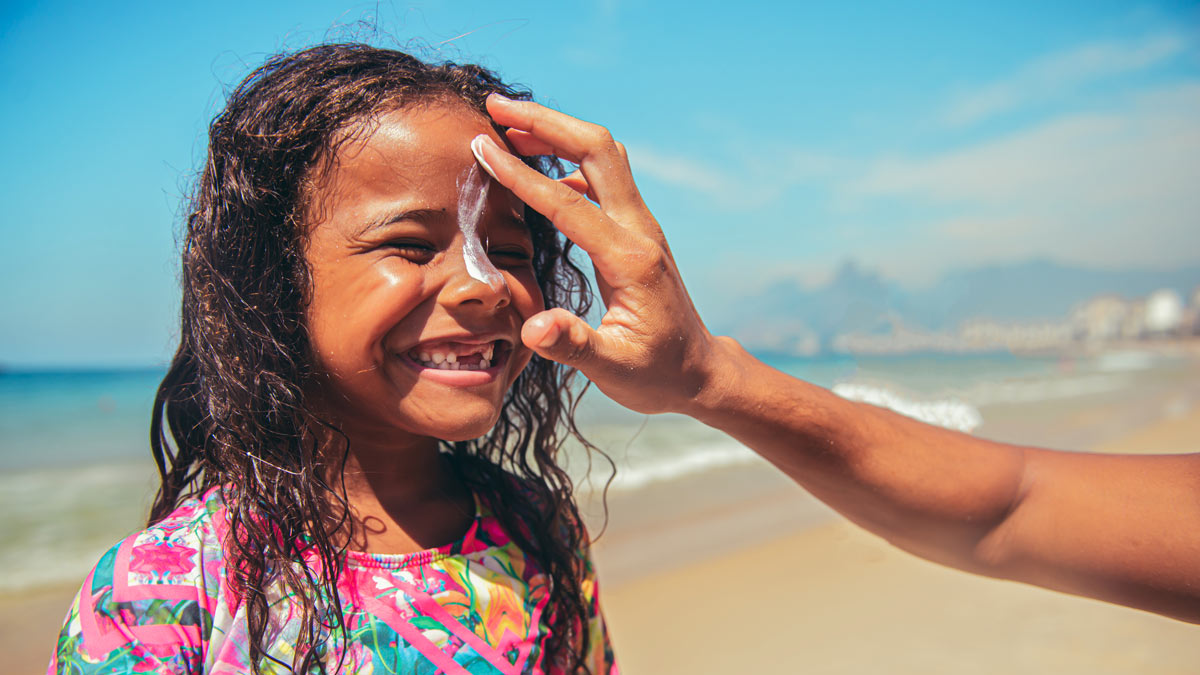
Australia has one of the highest skin cancer rates in the world. Sunscreen plays an important role in protecting not only against skin cancer, but also sunburn and premature ageing.
On this page:
- What is sunscreen?
- UV rays explained
- Sunscreen and SPF
- Physical (mineral) vs chemical sunscreen
- Types of sunscreen application
- What to look for when buying a sunscreen
However, sunscreen is just one part of the equation. Other protective measures such as wearing protective clothing, a hat, sunglasses and avoiding the sun in the middle of the day all play their part in keeping your skin healthy and safe.
Sunscreen plays an important role in protecting not only against skin cancer, but also sunburn and premature ageing
Melanoma Institute Australia says regular use of sunscreen can reduce melanoma risk by 40%, but when sunscreen isn’t used properly – which usually means not using enough of it, or not reapplying often enough – people may not be getting the protection they expect.
With so many products on the market, choosing the right sunscreen can be overwhelming. Here we’ll take you through what you need to know about sunscreen, and what to look for when choosing one.
What is sunscreen?
Sunscreen, also known as sunblock or sun cream, comes in various applications but is usually a cream or lotion. It’s applied to exposed areas of the skin to help protect it from the harmful effects of the sun.
All sunscreens sold in Australia are regulated by the Therapeutic Goods Administration (TGA).
UV rays explained
When you’re out in the sun, you’re exposed to two forms of ultraviolet (UV) radiation: UVA and UVB. This exposure to UV radiation is the main cause of melanoma and other skin cancers.
A broad-spectrum sunscreen blocks both UVA and UVB rays. All sunscreens over SPF4 are required to be broad spectrum.
UVA
UVA penetrates deeply into the skin and is responsible for tanning. It also causes skin ageing, wrinkles and leathering (think “A” for ageing). It makes UVB-induced damage worse and increases your risk of developing some skin cancers. UVA penetrates clouds and car windows and is present at fairly consistent levels during daylight hours all year round.
UVB
UVB radiation penetrates the top layer of the skin and is the main cause of skin reddening and sunburn (think “B” for burns). It’s also the major cause of skin cancer and can contribute to tanning and skin ageing. UVB is also responsible for making vitamin D in our skin – for most people, incidental sun exposure is all you’ll need to get enough vitamin D.
UV levels
UV radiation levels vary based on a number of factors including:
- time of day
- season of year
- latitude (the closer to the equator, the higher the UV)
- altitude (the higher the altitude, the higher the UV)
- cloud cover
- reflective surfaces (e.g. water, sand and snow).
The UV index is a useful tool that is constantly measured and updated daily by the Australian Radiation Protection and Nuclear Safety Agency (ARPANSA) to educate you about UV levels so you know when you need to take sun safety precautions.
There are five levels to the UV index:
- Low (1–2)
- Moderate (3–5)
- High (6–7)
- Very high (8–10)
- Extreme (11 and above)
Sunscreen is a vital part of sun safety and the Australian Bureau of Meteorology says sun protection measures are recommended when the UV is 3 and above. Handy apps for UV index include the Bureau of Meteorology weather app and the Cancer Council’s free SunSmart app.
Sunscreen and SPF
When buying a bottle of sunscreen, you’ll find SPF with a number beside it on the label. We’ve been trained to aim for the highest SPF number, but what does it actually mean?
SPF (or sun protection factor) is a measure of how well a sunscreen protects you from sunburn. The number indicates how much longer it takes untanned skin to start to redden with sunscreen applied compared to how long it takes to start to redden without sunscreen.
How SPF is tested
The SPF rating is determined through laboratory testing on human volunteers.
Untanned skin is exposed to simulated UV light, with and without sunscreen applied. Testers measure how long it takes for the skin to redden. For example, if it takes 300 seconds for skin to burn with sunscreen, and 10 seconds for skin to burn without sunscreen, 300 is divided by 10 to give an SPF rating of 30.
Therefore, you’d expect a sunscreen with an SPF 30 rating to protect you for 30 times the amount of time than if you were wearing no sunscreen.
Currently in Australia the highest SPF rating is 50+ but to qualify for this rating under Australian regulations the sunscreen should have an SPF of 60 or more.
Does sunscreen protect from all UV radiation?
No, sunscreen does not protect you from all UV radiation. Regardless of how high the sunscreen’s SPF is, UV radiation can still penetrate through the skin.
- SPF 4 protects you from 75% of UV rays
- SPF 8 protects you from 87.5% of UV rays
- SPF 15 protects you from 93.3% of UV rays
- SPF 30 protects you from 96.7% of UV rays
- SPF 50 protects you from 98% of UV rays
Sunscreen is only one part of the picture when it comes to sun safety.
Physical (mineral) vs chemical sunscreen
There are two main types of sunscreens based on their active ingredients: physical sunscreen and chemical sunscreen.
Physical sunscreen
Physical sunscreen (also known as mineral sunscreen) contains zinc oxide or titanium dioxide as its active ingredients. These create a physical barrier on the skin to deflect or scatter UV rays away from your skin. This type is generally recommended for people with sensitive skin.
Chemical sunscreen
Chemical sunscreen absorbs UV rays and stops it from penetrating your skin. Common active ingredients in this type of sunscreen are homosalate and octocrylene. Chemical sunscreen can cause skin irritation.
Endocrine disruptors?
There’s also concern that some chemical sunscreens are endocrine disruptors – that is, they have hormonal effects in humans. These include oxybenzone, octyl methoxycinnamate, homosalate and 4-MBC. While this activity has been shown in animals and tissue tests, the doses used in testing are vastly greater than the amount used for human sun protection.
Sunscreens are regulated in Australia by the Therapeutic Goods Administration (TGA) and their ingredients must be approved and assessed for quality and safety.

Types of sunscreen application
There are many different ways you can apply sunscreen. The most commonly available products come in the form of lotions and creams, sprays and roll-ons.
Lotion and cream
Most sunscreens on the market come in the form of lotions and creams. These have the advantage of being cheap, easy to apply and easy to see where it’s been applied.
They come in various degrees of thickness so they can take a while to rub in, and they may leave your skin feeling sticky or greasy.
Spray
People like sprays for being easy to apply and for generally being less greasy than creams and lotions. But with sprays it’s easy to use too little and to miss areas, and you could miss out on getting the best level of protection. You also need to be careful when spraying near the mouth and eyes to not ingest or inhale any product.
Melanoma Institute Australia recommends only using a spray sunscreen during cooler parts of the day, being sure to apply a generous amount, saying sprays aren’t as effective at reflecting light as more physical blockers such as lotions, creams and sticks.
Roll-on
Roll-on sunscreen is small, portable and easy to apply to small areas, but difficult to apply evenly over a larger area, so it’s not ideal for full body application.
Stick
A sunscreen stick is probably only useful for small areas like the face. It’s dry and therefore mess-free (although it’s sticky when it’s on), and compact enough to keep handy in your bag.
Gel
Being water-based, gel sunscreen won’t leave your skin feeling sticky or greasy, and is usually easier to rub in. People with a lot of body hair may find gel more comfortable to apply than other types of sunscreen.
Powder
Powder sunscreen is brushed on like foundation powder and is best for small areas of skin like the face. Dry and non-greasy, it could be useful over make-up or for touch-ups during the day. Just make sure you use enough.
Foam
This is a relatively new type of sunscreen that’s fast and easy to apply, and easy to visually assess coverage on the body. But making sure you use enough can be tricky – a large cupped handful per section of the body (5.7–6g) is usually recommended, which you can achieve with about three seconds of spray.
Sunscreen with insect repellent
Products that combine sunscreen and insect repellent are generally not recommended, as requirements for the amount and frequency of application are different for each purpose. Sunscreen should be applied generously every two hours. Insect repellants should be applied more sparingly, every two to six hours depending on the concentration, and you should avoid the face.
It’s also worth noting that using a personal insect repellent containing N,N-Diethyl-m-toluamide (DEET) can reduce a sunscreen’s effectiveness by about 30%.
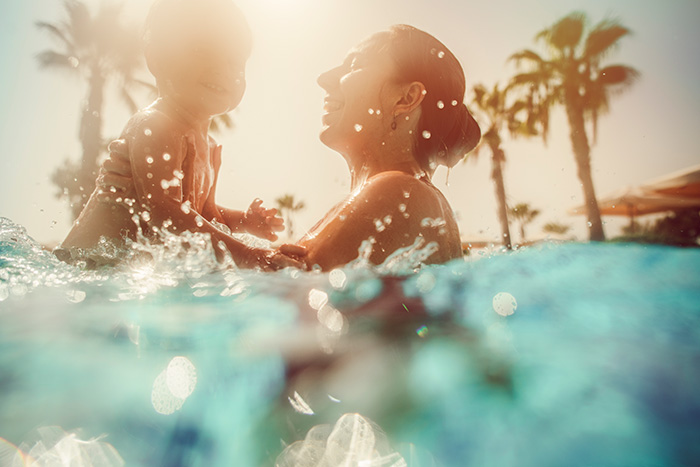
What to look for when buying a sunscreen
SPF
Use SPF 50+ sunscreen for maximum benefit. But effectiveness also comes down to application – an SPF 30 sunscreen that’s applied properly will work better than a SPF 50+ sunscreen that isn’t applied properly.
Broad spectrum
This provides protection against both UVA and UVB rays, which is important. While UVB is the cause of sunburn, both can contribute to an increased risk of skin cancer.
Price
All sunscreens on the market must be listed with the Therapeutic Goods Administration (TGA) and tested and rated according to Australian standard AS/NZS 2604:2021. So the cheapest 50+ sunscreen should provide you with the same protection as the most expensive.
Water resistance
If you’re going swimming, look for a product that says it’s water-resistant. Don’t be misled by labels that say “4 hours water resistance” – it may well stay on your body for this amount of time, but should be reapplied more frequently for maximum benefit. Reapply after swimming or exercise, and otherwise at least every two hours.
Products for children and sensitive skin
Some sunscreens are marketed specifically for toddlers, infants and children. These may contain more physical blockers and fewer chemical filters, and so may also be more suitable for adults with sensitive skin. Consult your dermatologist about the best options for you.
It’s best to keep babies out of the sun (where the UV index is 3 or more) as much as possible for the first 12 months. If it’s unavoidable, use a hat, clothing and shade for protection, using sunscreen as a last resort to cover any unprotected skin. Melanoma Institute Australia recommends that instead of using sunscreen, newborns should be kept in the shade until they are at least six months old.
Top tips for using sunscreen
- Apply sunscreen to clean, dry skin 15 to 30 minutes before you go out in the sun to allow it time to interact with your skin. Then reapply it just before you go out – you’ll increase the amount applied and be more likely to get the stated SPF benefit.
- Cover all parts of the body not protected by clothing (don’t forget your ears, the back of your neck, the backs of your hands and the tops of your feet).
- Apply it evenly, and don’t rub it in excessively – most sunscreens will absorb into the outer layer of skin and don’t need to be rubbed in vigorously.
- Reapply at least once every two hours, especially after swimming or exercise.
- Think beyond the beach and pool – use sunscreen whenever you go outdoors for a significant amount of time, such as to the park, a lunchtime walk to the shops, playing sports or gardening.
- Store your sunscreen at a temperature of less than 30°C. If you leave it in the glovebox of your car or in the sun, it may lose its effectiveness. If you’re at the beach, keep it in the esky with the drinks, in the shade or wrapped in a towel.
- When buying sunscreen, aim for those that have the furthest expiry date.
- Don’t use sunscreens that have passed their expiry date as some of the active ingredients may have broken down and the sunscreen can lose its effectiveness.
- If you’re trying a new sunscreen and have sensitive skin, do a patch test on your inner arm and leave it for 24 hours to see if there’s any reaction.
- Sunscreen is only a secondary and partial defence. First and foremost, try to avoid the sun in the middle of the day.
Other sun safety measures
There’s no denying the importance of using sunscreen, but it’s only a partial defence against UV radiation and keeping your skin safe when you’re in the sun. When you’re spending time outdoors remember the following:
- Slip on protective clothing.
- Slop on SPF 50+ sunscreen that’s broad spectrum and water resistant whenever the UV index is 3 or higher.
- Slap on a hat (ideally one that protects the face, neck and ears).
- Seek shade (especially during times when the UV is high).
- Slide on sunglasses.
If you’re going to be on a beach, investing in a shade or shelter is a great way to help you stay sun-safe.
Some skin cancer experts are concerned that sunscreens lull people into a false sense of security, and they’ll stay in the sun longer – a fact borne out in a number of studies – therefore exposing themselves to the potentially more damaging UV radiation.
However, that doesn’t mean that you shouldn’t use sunscreens – only that you should be aware of its limitations, and not rely on it for complete protection.
Can you still tan when wearing sunscreen?
Sunscreen will largely prevent tanning provided you’re using enough of it and reapplying often. However, no sunscreen blocks 100% of UV rays so if you’re not using any other sun safety measures and using sunscreen alone, tanning is still possible.
Does sunscreen expire?
Yes. Sunscreens should not be used after their expiration date. The active ingredients degrade over time and lose their effectiveness.
Should you still wear sunscreen during the cooler months or on a cloudy day?
Many skin care experts recommend sunscreen use every day.
Sunburn is caused by UV radiation, not heat, so you shouldn’t rely on the temperature of the day to determine if it’s time to wear sunscreen. UV rays can penetrate clouds and cause sun damage even on an overcast day so it’s a good idea to check the UV index daily.
Are there nanoparticles in sunscreen?
Nanoparticles have been widely used in sunscreens for many years, however, current research has found that they don’t pose a risk. Unless the skin is broken or you suffer from dermatitis, they cannot penetrate the outer layers of the skin.

